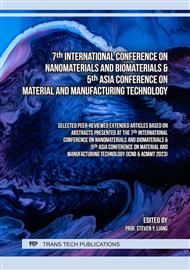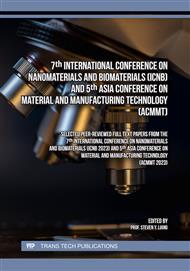p.3
p.9
p.15
p.21
p.27
p.35
p.41
p.47
Morphological and Characterization Analysis of PCL/Estradiol Electrospun Membrane for Bone Regeneration Application
Abstract:
Extensive research is currently focused on finding alternative treatment for bone regeneration, due to the complexity and risks associated with existing procedures. One such alternative under investigation is the utilization of biodegradable nanofiber membranes, fabricated using an electrospinning method. In this study, polycaprolactone (PCL) was used as the main matrix to form electrospun membranes at different electrospinning parameters with the incorporation of estradiol to address bone regeneration capability. The effects of estradiol incorporation within the PCL membranes while determining the appropriate electrospinning parameters through morphological, chemical functionalities and wettability analyses were investigated. The inclusion of estradiol into the PCL matrix has reduced the nanofiber diameter and improved the wettability properties of the membranes. The alterations of electrospinning voltage and flow rate also impacted on the reduction of fiber diameter and wettability, which highlights the membrane’s potential for further cell attachment and bone regeneration.
Info:
Periodical:
Pages:
9-14
Citation:
Online since:
March 2024
Keywords:
Price:
Сopyright:
© 2024 Trans Tech Publications Ltd. All Rights Reserved
Share:
Citation:



